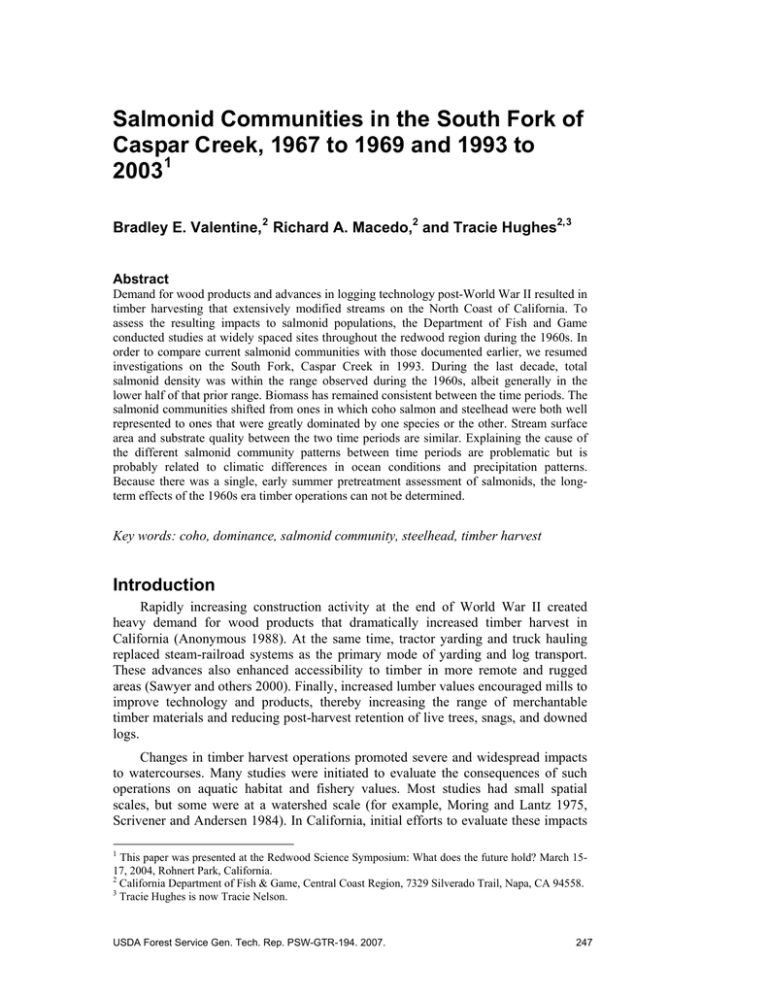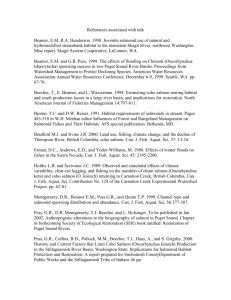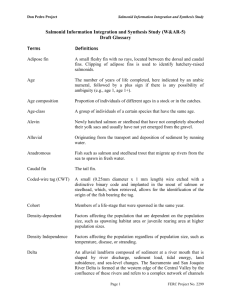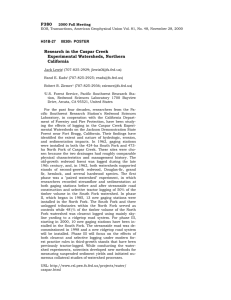Salmonid Communities in the South Fork of 2003 Bradley E. Valentine,
advertisement

Salmonid Communities in the South Fork of Caspar Creek, 1967 to 1969 and 1993 to 20031 Bradley E. Valentine, 2 Richard A. Macedo,2 and Tracie Hughes2,3 Abstract Demand for wood products and advances in logging technology post-World War II resulted in timber harvesting that extensively modified streams on the North Coast of California. To assess the resulting impacts to salmonid populations, the Department of Fish and Game conducted studies at widely spaced sites throughout the redwood region during the 1960s. In order to compare current salmonid communities with those documented earlier, we resumed investigations on the South Fork, Caspar Creek in 1993. During the last decade, total salmonid density was within the range observed during the 1960s, albeit generally in the lower half of that prior range. Biomass has remained consistent between the time periods. The salmonid communities shifted from ones in which coho salmon and steelhead were both well represented to ones that were greatly dominated by one species or the other. Stream surface area and substrate quality between the two time periods are similar. Explaining the cause of the different salmonid community patterns between time periods are problematic but is probably related to climatic differences in ocean conditions and precipitation patterns. Because there was a single, early summer pretreatment assessment of salmonids, the longterm effects of the 1960s era timber operations can not be determined. Key words: coho, dominance, salmonid community, steelhead, timber harvest Introduction Rapidly increasing construction activity at the end of World War II created heavy demand for wood products that dramatically increased timber harvest in California (Anonymous 1988). At the same time, tractor yarding and truck hauling replaced steam-railroad systems as the primary mode of yarding and log transport. These advances also enhanced accessibility to timber in more remote and rugged areas (Sawyer and others 2000). Finally, increased lumber values encouraged mills to improve technology and products, thereby increasing the range of merchantable timber materials and reducing post-harvest retention of live trees, snags, and downed logs. Changes in timber harvest operations promoted severe and widespread impacts to watercourses. Many studies were initiated to evaluate the consequences of such operations on aquatic habitat and fishery values. Most studies had small spatial scales, but some were at a watershed scale (for example, Moring and Lantz 1975, Scrivener and Andersen 1984). In California, initial efforts to evaluate these impacts 1 This paper was presented at the Redwood Science Symposium: What does the future hold? March 1517, 2004, Rohnert Park, California. 2 California Department of Fish & Game, Central Coast Region, 7329 Silverado Trail, Napa, CA 94558. 3 Tracie Hughes is now Tracie Nelson. USDA Forest Service Gen. Tech. Rep. PSW-GTR-194. 2007. 247 Session 6—Salmonid Community Trends in Caspar Creek—Valentine, Macedo, and Hughes were both extensive (Burns 1972) and intensive (Ziemer 1998). The studies in total have generally found impacts to salmonids mediated through changes in solar radiation and temperature; reductions in channel complexity due to modified large woody debris loading and increased delivery of coarse sediment; and modifications in productivity through fining of the spawning beds and changed stability. Anadromous salmonid populations across the west coast have been declining for some time, possibly due to a combination of both freshwater and marine conditions. For example, summarizing information mainly taken from Brown and others (1994), the NMFS (Weitkamp and others 1995) estimated that coho salmon (Oncorhynchus kisutch) escapement in California ranged between 200,000 and 500,000 in the 1940s, but had declined to an average of about 31,000 from 1987 to 1991, and that they were apparently extirpated from 46 percent of the streams with historic records. The National Marine Fisheries Service (Weitkamp and others 1995) also noted that traditional assessment of salmon populations had focused on the number of harvestable or reproductive adults but that data on other life history stages (for example, freshwater smolt production) can be used as supplemental indicator of abundance. In response to the mounting evidence of declining salmonid stocks, the National Marine Fisheries Service listed several Evolutionarily Significant Units of anadromous salmonids including coho and steelhead (O. mykiss) in California and the Pacific Northwest under the federal Endangered Species Act. Little long-term trend information has been collected on juvenile salmonids. Yet, assuming juvenile populations are habitat limited (Burns 1971), trends in their numbers can provide insights into freshwater habitat conditions, a life stage which is an integral but not necessarily the most limiting portion of their life history. Motivated by this tenant and the availability of historic data (Burns 1970, 1972) against which to compare, a monitoring program was activated on the Little North Fork of the Noyo in 1992 (since assumed by Campbell Timberland Management) and the South Fork of Caspar Creek in 1993. This articles reports on the juvenile salmonid populations in the South Fork of Caspar Creek. Methods Burns’ Era Methods used during the 1967 to 1969 are more fully described in Burns (1970, 1971, 1972). Because this work was extensive, varied between watercourses, and was not always specified by study site, exact methods used at any one site are speculative. For instance, Burns used both mark-recapture and depletion methods to estimate populations in his study sites, so the method applied at any site must be inferred based on conditions described in his articles. For spawning gravel analyses, Burns (1970) collected 20 samples mid-stream near the head of a riffle using a 15.24 cm diameter and 15.24 cm deep core ‘McNeil’ sampler. Samples were passed through sieves with 26.6, 3.327, and 0.833 mm openings and the fine materials were collected in a pan. Water displacement was used to determine volume of each screened sample. Residual sediments from the pan were measured in graduated cylinders after settling for 10 minutes. To assess salmonid numbers, Burns sampled with a backpack electrofisher in June and October of each year from 1967 through 1969. He separated age classes by 248 USDA Forest Service Gen. Tech. Rep. PSW-GTR-194. 2007. Session 6—Salmonid Community Trends in Caspar Creek—Valentine, Macedo, and Hughes length-frequency methods and estimated population sizes probably with markrecapture methods. To convert population estimates to density estimates, Burns measured stream dimensions using cross sections at probably 101 transects (average of one transect every 30 m). Since Burns reports the area of his study reaches but not the individual measures, we back-calculated average width during his studies from his length and surface area summary data (Burns 1972). Burns’ study reach was a continuous reach that ranged from 2,723 to 3,091 m between samples. The varied reach lengths likely reflected differences in available habitat between water years. Burns’ efforts spanned from a single pre-impact sampling (June 1967), to immediately after clearing and constructing the roads (October 1967), then through two years of continued road maintenance (June and October 1968 and 1969). Recent Methods Since 1993, we have sampled biota in four index reaches each approximately 100 m in length. Index reaches were selected non-randomly to meet two goals: to span Burns’ study site and to sample distinctly different habitat conditions. Stream dimensions (wetted width and three equidistant water depths) were recorded at crossstream transects every five or ten m within the sampled reach. Depths and locations of all pools were also measured. We weighed all collected vertebrates using an electronic scale (±0.1 g) calibrated at each pass. We measured fork-length (±1 mm) of salmonids, total length (±1 mm) of other fish taxa, and snout-vent length (±5 mm) of Pacific giant salamanders (Dicamptodon tenebrosus). We estimated population size in each index reach using multiple-pass, depletion methods (Carle and Strub 1978). We used Price (1982) to determining the number of passes required for a total salmonid population estimate with a less than a ten percent error. Bulk sediment samples were collected and processed according to Valentine (1995), essentially identically to Burns (1970). Results From the pre-road construction effort in June of 1967 to the first autumn, Burns (1971) noted an approximately 85 percent decrease in both coho and steelhead density (fig. 1). In each subsequent year, density declined from the June sampling effort to the October effort, but by much smaller amounts. Both coho and steelhead showed positive October trends for the subsequent two years, suggesting that habitat conditions were recovering. However, a comparison between coho trends in North Fork of Caspar Creek, a control watercourse, and the South Fork suggested otherwise. In the South Fork, Burns found that coho populations were 2.3 times as dense in October 1969 than in October 1967. But in the North Fork, coho density increased by a factor of 15 over the same period. During each of Burns’ sampling periods, coho comprised a significant proportion (range 27 to 40 percent) of total salmonid density. During the 1993 through 2003 period, total salmonid density (range 0.33-0.96 fish/m2) fluctuated just below to within the lower 1/2 of the range of Burns’ October estimates (0.52-1.33 fish/m2, fig. 1). With the exception of 1996, 2002, and 2003, coho were rare or absent during our study. Coho were nearly absent for three consecutive years (1998 to 2000); encompassing a complete cohort cycle. However, coho dominated (59 to 88 percent) the salmonid population in the final two years (2002 and 2003), and production of steelhead was nil in 2002. USDA Forest Service Gen. Tech. Rep. PSW-GTR-194. 2007. 249 Session 6—Salmonid Community Trends in Caspar Creek—Valentine, Macedo, and Hughes 3 2.5 D e n sity (n /m ^ 2 ) 2 1.5 1 0.5 0 20 20 20 20 19 19 19 19 19 19 19 03 02 01 00 99 98 97 96 95 94 96 69 96 68 96 67 93 /1 /1 19 10 6/ 19 10 6/ /1 19 10 6/ 9 8 7 Month and Year Coho Salmon YOY Steelhead 1+ Steelhead All salmonids Figure 1—Density (#/m2) of salmonids in the South Fork of Caspar Creek, 1967 to 1969 and 1993 to 2003. Biomass (fig. 2) shows similar changes as does density, although generally not as severe. By June of 1969, total salmonid and steelhead biomass were very similar to the pre-road building timber harvest (June 1967), while changes in coho and young of the year steelhead biomass suggested recovery. Relative coho biomass changes in the North Fork and the South Fork also suggested differential recovery. Coho salmon biomass in October 1969 for the South Fork was 1.3 times that in October 1967, while coho biomass in the North Fork increased by a factor of five over the same time. Like density, biomass declined dramatically during the first summer. Total salmonid biomass from 1993 to 2003 (range 15.71 to 31.15 kg/ha) was similar to that observed by Burns during his October samples (range 14.92 to 30.38 kg/ha). Total salmonid biomass reflected the species composition: steelhead accounted for most of the salmonid biomass prior to 2002. However, in three years (1996, 2002, and 2003), coho biomass exceeded even the values observed during the October samples from 1967 to 1969. Substrate particle size indices varied widely (fig. 3). The greatest within-year change was observed in 1967, when percent fines <0.8 mm increased from 20.6 percent to 34.2 percent, presumably in response to road construction activity. Within subsequent years, differences between June to October substrate values were negligible. Percent of fines <0.8 mm were marginally lower in the first spring after road-building than they were prior to harvest, suggesting that the fines had flushed during the preceding winter. However, percentage of fines <0.8 mm increased in June of 1969, apparently in response to stream bank erosion, erosion on road sidecast, and slides. Percentages of particles <3.3 mm showed parallel changes to that of the fines <0.8 mm category. Samples taken in 1993 were within the 1967 to 1969 range, suggesting spawning gravel quality was similar to the earlier samples and thus could not explain density and community structure differences between the periods. 250 USDA Forest Service Gen. Tech. Rep. PSW-GTR-194. 2007. Session 6—Salmonid Community Trends in Caspar Creek—Valentine, Macedo, and Hughes 40 35 30 Biomass (kg/ha) 25 20 15 10 5 03 20 02 20 01 99 00 20 20 19 98 19 96 95 97 19 19 19 94 19 93 19 69 68 69 /1 9 19 10 6/ 68 /1 9 10 19 6/ /1 9 10 6/ 19 67 67 0 Date Coho Salmon YOY Steelhead 1+ Steelhead All Salmonids Figure 2—Biomass (kg/ha) of salmonids in the South Fork of Caspar Creek, 1967 to 1969 and 1993 to 2003. Figure 3—Mean (and 95 percent CI) condition of substrate in the South Fork of Caspar Creek expressed as the percentage of a sample smaller than two particle size criteria. USDA Forest Service Gen. Tech. Rep. PSW-GTR-194. 2007. 251 Session 6—Salmonid Community Trends in Caspar Creek—Valentine, Macedo, and Hughes Average width during the 1967 to 1969 autumn samples generally declined (fig. 4), suggesting a deepening and narrowing of the wetted channel. When evaluating all sampling periods, average width during the two study periods were similar. But considering autumn samples only, the wetted channel during 1993 to 2003 tended to be slightly wider (175.9 cm ± 8.9 95 percent CI) than it was during 1967 to 1989 (152.5 cm ± 19.1 95 percent CI). This suggest that any deepening and narrowing that began immediately after the initial impacts did not continue, and may have slightly reversed after years of processing the land-management delivered sediment. However, the data were not collected in such a means to enable statistical comparison. 250.0 200.0 Width (cm) 150.0 100.0 50.0 /2 00 3 10 /2 00 1 /2 00 2 10 10 /2 00 0 10 /1 99 8 /1 99 9 10 10 /1 99 6 /1 99 5 10 10 /1 99 3 10 19 69 /1 96 9 10 6/ /1 96 8 10 19 68 6/ /1 96 7 10 6/ 19 67 0.0 Date Figure 4—Average width (cm) of South Fork Caspar Creek. Discussion and Conclusions There are two primary differences apparent when comparing Burns’ salmonid communities with ours. First, the autumn total salmonid density during the 1993 to 2003 period was slightly more stable and averaged lower but still within the lower part of the range reported by Burns (1972). Secondly, during Burns study the densities of steelhead and coho were relatively more even than during the last decade when one species has always dominated the salmonid community. The shift to strong species dominance appeared in the South Fork in 1989 (Nakamoto 1988), who found in sampling from 1986 through 1995 similar total densities and biomass as we found. These patterns may have resulted from the land management practices and subsequent habitat recovery, or temporal differences in variability of natural drivers of salmonid density. The between-year October increases in total salmonid density observed by Burns may reflect short term recovery processes in the physical habitat as streamflows processed the disturbed channels. It may also reflect reductions in predator pressure, climatic and streamflow changes, or increases in nutrient 252 USDA Forest Service Gen. Tech. Rep. PSW-GTR-194. 2007. Session 6—Salmonid Community Trends in Caspar Creek—Valentine, Macedo, and Hughes availability. Timber management near streams can result in increased solar radiation, higher invertebrate densities and improved forage conditions for some salmonid species provided that that water temperature regimes remain within tolerable ranges (Murphy and others 1986). Burns (1972) reported that solar radiation increased an average of 98 Langley’s/day, and that water temperature increased as much as 11.1 °C. After the right of way clearing and road building, urea was spread with the grass seed sown for erosion control. Burns (1972) reported that, within a two year period following road construction, benthos in the South Fork increased 370 over that which existed prior to road construction. All these factors enhanced available food base and likely enhanced salmonid growth. These land management changes to the food-base and channel should have become relative stabile with time as the channels and stream-side zones recovered. Beyond the land management induced changes and subsequent recovery, variation in natural conditions may subsequently drive variation in density of juvenile salmonids. Marine conditions (Beamish and others 2004) can affect the number of adults available to return. Differential flow patterns can affect the strength and success of the spawning run both between and within years (Lisle and Lewis 1992). The simplification of salmonid communities expressed by the greater dominance of one species in the South Fork could reflect other factors. Reeves and others (1993) found that basins subjected to high levels of timber harvest are more likely to be dominated by a single species, and attributed that change to habitat simplification. In the South Fork, the same mechanism may play a role in the single species domination we observed. Whether predation might differentially and variably affect the salmonid species abundance in Caspar Creek is unknown. As top carnivore of Pacific Northwest aquatic communities, giant salamanders may exert a controlling influence on populations of salmonid especially through predation on alevins and juveniles. During the last decade, Pacific giant salamanders have been generally as numerous as the salmonids. Unfortunately, Burns did not report on salamander density or biomass, thus eliminating our ability to use temporal differences to assess their possible community structuring role. A weir was constructed on the South Fork in 1962 (Anonymous 1970). Over the years, the weir’s fish ladder deteriorated and may have been a migration barrier under some flow conditions. Repairs completed in 1998 may have improved coho access upstream of the weir and into our study sites. However, this does not fully explain recent increases in South Fork coho salmon populations: the ladder still is not fully functional, Nakamoto (1998) recorded strong coho density up through 1989, and a similar species shift has been noted in the Little North Fork of the Noyo River, 4 a stream that does not have a similar migration barrier. Despite the similarity in total salmonid biomass between 1967 to 1969 and 1993 to 2003, population densities were generally lower during the last decade. This contradiction could be explained by density dependant interactions among and between salmonids species (Chapman 1966). If a watercourse’s carrying capacity declines across the summer period in varying but non-linear ways, salmonid populations may pass through a bottleneck and then enter a period where survivors experience reduced density-dependent pressure and enhanced growth. The contradiction could also be explained by the enhanced food resources observed by 4 Unpublished data, David Wright, Campbell Timberland Management. USDA Forest Service Gen. Tech. Rep. PSW-GTR-194. 2007. 253 Session 6—Salmonid Community Trends in Caspar Creek—Valentine, Macedo, and Hughes Burns (1972) being diminished as the adjacent forest regrows. Gregory and others (1987) noted that timber harvest enhanced nutrient levels persist for ten to 20 years followed by a decline in primary production during the following 40 to 80 years of deciduous forest stage. There has been little change in wetted width and no change in channel substrate quality. As measured on the South Fork, these parameters provide little insight into the changes we observed in salmonid community structure. Bulldozer-assisted rightof-way clearing, road building, and stream channel clearing notably simplified the South Fork channel. Evidence persists today where the channel’s cross section appears to be about one bulldozer blade wide in many locations (Valentine, pers. observ.). Recovery of the channel has been slow, as embedded LWD is gradually being exposed and off-channel LWD recruitment is initiating. The two decade lull in habitat change is consistent with Knopp (1993), who found that recovery from timber harvest impacts to watercourse metrics may be slow. He found various stream aquatic habitat indices were similar between recently managed (timber harvest) landscapes and those that had a 40 year break in management. However, he found that the same metrics differed significantly between unharvested basins and those which had been subjected to past management. The fact that total salmonid density fluctuated somewhat less during 1993 to 2003 than during the samples of 1967 to 1969 is somewhat surprising based on general stream flow and climatic conditions. According to the Palmer Drought Severity Index (NCDC 2005), Burns experienced relatively stable and near normal climatic conditions before and during his studies. On the other hand, our sampling efforts included, and were preceded by years of widely varying and prolonged weather and stream flows conditions. The effects of storm flows on salmonid reproduction is specific to timing and magnitude and is mediated through controlling access to spawning areas and dynamics of redd scour (Lisle and Lewis 1992). Late summer and early fall is a common period for conducting juvenile salmonid surveys. At this time of year, populations have experienced the stress of low flow and high temperature of summer, and have therefore provided biologists an insight into existing habitat quality. This sampling period will not capture another critical period that may limiting populations—the high runoff and turbidity conditions that accompany winter storm runoff (Nickelson and others 1992). Numerically and by biomass, 1+ steelhead were never dominant, but during the last decade, their density has been slightly greater than during the post impact period of Burns study. Since these fish have over-wintered prior to our sampling period, this suggests some improvement recently in winter habitat. Unfortunately, Burns (1972) only had one sampling period (June 1967) that preceded the treatments he evaluated. The June 1967 sample period does not provide much insight into late summer salmonid populations under unmanaged conditions. A single point for examining parameters with substantial variability leaves us with scarce “pre-treatment” data against which to assess the long-term impacts of timber harvest Acknowledgments This study would not have been possible without the strong encouragement of Jackson Demonstration State Forest Manager Marc Jamison. Support was also provided by Carl Wilcox of the Central Coast Region of the Department of Fish and 254 USDA Forest Service Gen. Tech. Rep. PSW-GTR-194. 2007. Session 6—Salmonid Community Trends in Caspar Creek—Valentine, Macedo, and Hughes Game. Over the years, many people have assisted in field data collection—attempting to acknowledge them all would lead to unintended oversights, so we thank them all. References Anonymous. 1970. Timber harvest and logging plan for the South Fork of the Caspar Creek watershed. Unpublished Report. Anonymous. 1988. California’s forests and rangelands: Growing conflict over changing uses. California Department of Forestry and Fire Protection, Forest and Rangeland Resources. Beamish, R.J.; Sweeting, R.M.; Neville, C.M. 2004. Improvement of Juvenile Pacific Salmon Production in a Regional Ecosystem after the 1998 Climatic Regime Shift. Trans. Am. Fish. Soc.133: 1163-1175. Brown, L.R; Moyle, P.B.; Yoshiyama, R.M. 1994. Historical decline and current status of Coho Salmon in California. N. Am. J. Fish. Manage. 14: 237-261. Burns, J.W. 1970. Spawning bed sedimentation studies in Northern California Streams. Calif. Fish & Game 56(4): 253-270. Burns, J.W. 1971. The Carrying Capacity for Juvenile Salmonids in Some Northern California Streams. Calif. Fish & Game 57(1): 44-57. Burns, J.W. 1972. Some effects of logging and associated road construction on northern California streams. Trans. Am. Fish. Soc. 101(1): 1-16. Carle, F.L.; Strub, M.R.. 1978. A new method for estimating population size from removal data. Biometrics 34: 621-630. Chapman, D.W. 1966. Food and space as regulators of salmonid populations in streams. Am. Nat. 100: 345-357. Gregory, W.V.; Lamberti, G.A.; Erman, D.C.; Koski, K.V.; Murphy, M.L.; Sedell, J.R. 1987. Influence of forest practices on aquatic production. In: Salo, E.O.; Cundy, T.W., eds., Streamside Management: Forestry and Fishery Interactions. Institute of Forest Resources. Univ. of Washington, Contrib. 57. Seattle, WA; 233-255. Knopp, C. 1993. Testing Indices of Cold Water Fish Habitat. Final Report to the North Coast Regional Water Quality Control Board. Santa Rosa, CA. 55 p. Lisle, T.E.; Lewis,J. 1992. Effects of sediment transport o survival of salmonid embryos in a natural stream: A simulation approach. Can. J. Fish. Aquat. Sci. 49: 2337-2344. Moring, J.R.; Lantz, R.L. 1975. The Alsea Watershed Study: Effects of logging on the aquatic resources of three headwater streams of the Alsea River, Oregon. Part I— Biological Studies. Oregon Dept. Fish Wildl. Fish Res. Rept. No. 9.; 66 p. Murphy, M.L.; Heifetz, J.; Johnson, S.W.; Koski, K.V.; Thedinga, J.F. 1986. Effects of clearcut logging with and without buffer strips on juvenile salmonids in Alaskan streams. Can. J. Fish. Aquat. Sci. 43: 1521-1533. USDA Forest Service Gen. Tech. Rep. PSW-GTR-194. 2007. 255 Session 6—Salmonid Community Trends in Caspar Creek—Valentine, Macedo, and Hughes Nakamoto, R.M. 1998. Effects of timber harvest on aquatic vertebrates and habitat in the North Fork Caspar Creek. In: Ziemer, R.R., technical coordinator. Proceedings of the conference on coastal watersheds: The Caspar Creek Story. Gen. Tech. Rep. PSW-168. Albany, CA: Pacific Southwest Research Station, Forest Service, U.S. Department of Agriculture; 87-96. National Climate Data Center (NCDC). 2005. See http://lwf.ncdc.noaa.gov/oa/climate/ onlineprod/drought/xmgrg3.html Nickelson, T.E.; Rodgers, J.D.; Johnson, S.L.; Solazzi, M.F. 1992. Seasonal changes in habitat use by juvenile coho salmon (Oncorhynchus kisutch) in Oregon coastal streams. Can. J. Fish. Aquat. Sci. 49(4): 783-789. Price, D.G. 1982. A fishery resource sampling methodology for small streams. Pacific Gas & Electric Co., Dept. Eng. Res. Rep. 420-81.141; 49 p. Reeves, G.H.; Everest, F.H.; Sedell, J.R. 1993. Diversity of Juvenile Anadromous Salmonid Assemblages in Coastal Oregon Basins with Different Levels of Timber Harvest. Trans. Amer. Fish. Soc. 122: 309-317. Sawyer, J.O.; Gray, J.; West, G.J.; Thornburgh, D.A.; Noss, R.F.; Engbeck, Jr. J.G.; Marcot, B.G.; Raymond, R. 2000. History of Redwood and Redwood Forests, Chapter 2. In: Noss, R.F., ed. The Redwood Forest. Covelo, CA: Island Press; 339 p. Scrivener, J.C.; Andersen, B.C. 1984. Logging impacts and some mechanisms that determine the size of spring and summer populations of coho salmon fry (Oncorhynchus kisutch) in Carnation Creek, British Columbia. Can. J. Fish Aquat. Sci. 41: 1097-1105. Valentine, B.E. 1995. Stream substrate quality for salmonids: Guidelines for sampling, processing and analysis. In: Duncan-Vaughn, J., ed. Proceedings of the thirteenth annual Salmonid Restoration Federation Conference; 76-79. Weitkamp, L.A.; Wainwright, T.C.; Bryant, G.J.; Milner, J.B.; Teel, D.J.; Kope, R.G.; Waples, R.S. 1995. Status review of coho salmon from Washington, Oregon, and California. U.S. Dep. Commer., NOAA Tech. Memo. NMFS-NMFSC-24; 258 p. Ziemer, R.R., technical coordinator. 1998. Proceedings of the conference on coastal watersheds: The Caspar Creek Story. Albany, CA: Pacific Southwest Research Station, Forest Service, U.S. Department of Agriculture, Gen. Tech. Rep. PSW-168; 149 p. 256 USDA Forest Service Gen. Tech. Rep. PSW-GTR-194. 2007.





